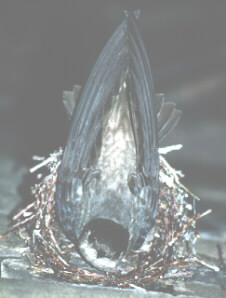Chimney Swift (Chaetura pelagica)

TPWD ©
- Description
- The summer skies are filled with many species of birds. However, none seem to be as much at home on the wing as the chimney swifts. Small, sleek, bluish-black with silver-gray throats, chimney swifts have been called "flying cigars" and "bows and arrows." Their stiff, acrobatic movements alternate with long, graceful sweeps of flight as they scour the skies for flying insects. While even the graceful swallows must perch to preen and socialize, the chimney swifts flicker on, chattering and careening endlessly throughout the day.
- Life History
- As captivating as their flight is to watch, their clandestine terrestrial behavior is even more remarkable. Unable to perch or stand upright as songbirds do, chimney swifts are uniquely equipped to roost clinging to vertical surfaces. Their small but strong feet are tipped with four sharp claws which act as grappling hooks to hold them firmly to their roost. Their tail feather shafts extend as stiff exposed spines to provide additional support for their vertical lifestyle.
- Habitat
- Although they will occasionally roost in the open, chimney swifts prefer the safety of an enclosed area such as a chimney, air shaft or abandoned building. It is in these inaccessible locations that they roost, build their nests, raise their families and congregate prior to migration.
- Distribution
- As a result of deforestation and the loss of large hollow trees as natural roosting and nesting sites, chimney swifts adapted to using man-made structures. Their ability to adapt has not only allowed chimney swifts to survive as a species, but it has caused their range to greatly expand. Migrating from as far as southern South America, chimney swifts come to the eastern and central half of the United States to breed. They are currently common from the east coast to the foot of the Rocky Mountains, but as recently as the 1940s, chimney swifts were rarely seen east of the Mississippi river. However, the use of metal chimneys and the increasing desire of homeowners to cap their chimneys have made these roosts scarce too. Since each breeding pair must have a site of their own to raise their young, suitable nesting sites are harder to find.
For more information
- To learn more about these beautiful birds and how you can help them, contact the Texas Partners in Flight Program, 4200 Smith School Road, Austin, TX 78744 for brochures.
- For additional information go to Driftwood Wildlife Association in Driftwood, Texas.